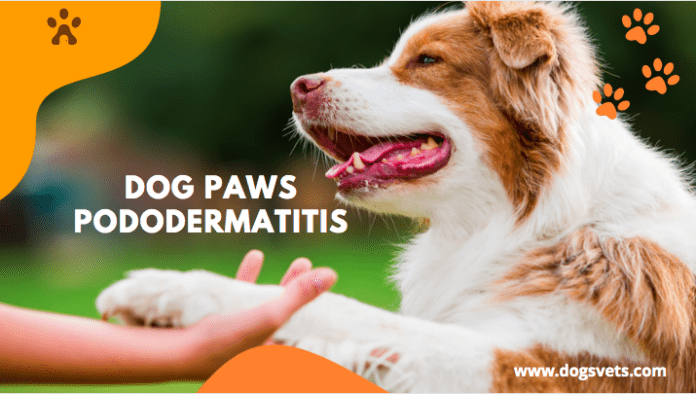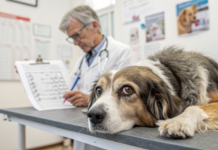Last Updated on April 9, 2022 by Dogs Vets
Ultimate Guide to Dogs Paws Pododermatitis
The term pododermatitis refers to any inflammation of the paws of dogs. Different causes are responsible for this condition.
Infections, allergies, and even diseases can be the culprit. Because of the various causes of inflammation of the paws, the diagnosis of this condition can be complicated.
In contrast, stomach pain can be caused by appendicitis, food poisoning, or gas.
Symptoms of dogs paws pododermatitis
Pedal pododermatitis in dogs is a common dermatologic condition. Symptoms can be mild or severe, and treatment may be either topical or a combination of both.
Your veterinarian may recommend prescription medication, or they may suggest an Elizabeth cone to prevent the dog from licking the infected area.
In some cases, a cold compress may be all that is needed to relieve symptoms.
Some of the causes of paw pododermatitis are bacterial, fungal, or environmental in nature. Your dog’s environment can cause your pup’s paws to become swollen and itchy.
The condition may be accompanied by bloody or pus-like discharge or a foul smell.
Sometimes it’s associated with allergies or underlying health problems. Breeds like German shepherds, English bulldogs, and boxers are at risk for this condition.
There are a variety of causes of pododermatitis in cats. Plasma cell pododermatitis, a form of immune-mediated disease, causes soft swelling, deformation, and ulceration of the paw pads.
This disease most often affects adult cats, but it can also occur in dogs. Symptoms of paw pododermatitis vary, so your cat should see a veterinarian if you suspect it.
Causes of dog Paws Pododermatitis
Pedal disease can occur in dogs, cats, and other pets. In some cases, a condition called paw pododermatitis occurs in a single or multiple digits.
The severity of paw pododermatitis depends on its underlying causes. Treatment can be lengthy or permanent, depending on the condition and severity of the symptoms.
To ensure a proper diagnosis, seek second opinions or referral to a veterinary dermatologist.
Infectious paw pododermatitis is often caused by an infection. Treatment is usually antibiotics, antifungal medications, or a topical cream.
Your veterinarian will probably also prescribe an Elizabeth cone to prevent your dog from licking the infected area.

If your dog has a foreign body in its paw, a vet will likely remove it. Systemic diseases like diabetes or cancer require a more thorough diagnosis and treatment. Allergic reactions cannot be treated.
A genetic predisposition to paw pododermatitis can also cause this disease. If both parents suffered from acrodermatitis, a pup from the affected parent could also develop the condition.
Allergies to certain foods:
Paw pododermatitis is a skin condition that can occur as a result of an allergic reaction to food, pollen, or other irritants.
If your dog suffers from seasonal or food allergies, it’s possible that they’ve been exposed to the allergens that are causing their paws to suffer as a result of canine atopic dermatitis (also known as canine atopic dermatitis).
Parasites:
Demodex mites are known to cause chronic pododermatitis and mange in humans and animals. When a dog has a persistent problem, it should be checked for demodex mites and other parasites such as hookworm and ticks and treated accordingly.
Environmental:
If your dog walks through excrement, vomit, stagnant water, or other contaminated items, the germs, parasites, and allergens on their paws can be transferred to them.
Contaminated material can become lodged between their footpads and toes, resulting in the development of pododermatitis that is absolutely invisible.
A thorn or a splinter may also have been encountered by your dog, which has become embedded in their skin and is creating this problem. This condition is also referred to as “contact dermatitis.”
Bacteria:
Infections caused by harmful bacteria can affect your pup’s paws and cause pododermatitis (paw pododermatitis). This condition can occur through skin contact, ingestion, or fluid exposure. It is usually possible to treat bacterial infections using antibacterial drugs, and the infection should clear up within a few weeks.
Infections caused by fungi:
Your dog may get severe pododermatitis sores and ulcers on their paws if they step in a fungus, which can spread throughout the environment.
It is also possible for dogs to contract ringworm, which is a fungal infection that can be contracted through the soil they walk over. Yeast infections are another type of illness that can be found on the paws of dogs.
Immune-related:
Diseases with your dog’s immune system can result in a variety of reactions and skin problems, including pododermatitis (foot dermatitis). Your veterinarian should look for and treat autoimmune illnesses such as pemphigus vulgaris if you suspect that you have one.
Hormonal and metabolic disorders:
Hormonal imbalance can also lead to pododermatitis, since hormonal changes weaken the skin’s immune system and make the paws prone to infections. However, even if pododermatitis is caused by genetics, there are many treatments available to help alleviate the symptoms.
Hormonal imbalances, particularly severe ones such as Cushing’s Disease and hypothyroidism, can cause a variety of disorders in dogs, including paw pododermatitis (paw pododermatitis).
If you’ve noticed that your dog is losing hair, eating or drinking excessively, or has sores or lesions on his or her paws, you should have them checked for Cushing’s disease as soon as possible.
Trauma to the nails. It is very easy for dogs to break their nails while they are running around on hard surfaces such as concrete. As the nail heals, it has the potential to get infected, resulting in painful sores.
Dog Paw Pododermatitis Treatment
Treatment of paw pododermatitis is the same as for any other allergic disease in pets. Often, it involves avoidance of known triggers, the use of antihistamines or steroids, and in some cases, allergy shots.
Occasionally, surgery is required to correct the condition. Depending on the cause, treatment may include surgery or antibiotics.
If you suspect an allergic reaction, consult your veterinarian or a dermatologist for further instructions.
In some cases, foreign bodies or a secondary infection are the culprits. A thorough skin scraping and allergy test are necessary to determine if the condition is caused by demodex mites.
In severe cases, a surgical procedure called fusion podoplasty is performed.
Surgical treatment of pododermatitis is limited to dogs with a history of severe scarring and foreign body removal. The condition may persist if the cause is not found.
If you notice patches of redness and crustiness on your dog’s paws, seek medical treatment immediately.
Depending on the etiology of the condition, it may be possible to cure pododermatitis. In cases of food or contact hypersensitivity, medications or dietary changes may be necessary.
If the skin disease is due to an infectious cause, systemic antibiotics may be prescribed. Antifungal medications are also useful for bacterial infections.
Questions and answers about pododermatitis
Is it possible for pododermatitis to go away on its own?
It is extremely rare for it to go away on its own. Paw pododermatitis is more than a simple skin irritation; it has a wide range of reasons, all of which necessitate a targeted and intentional approach to therapy.
Even more concerning, pododermatitis can be quite painful for dogs. That means that delaying treatment will only serve to prolong their anguish and misery. So, if you suspect that your dog may be suffering from paw pododermatitis, don’t hesitate to take them to the veterinarian.
Is pododermatitis in dogs a painful condition?
Yes. Depending on how severe their disease is, the level of pain your dog has can range from mild discomfort to severe, even crippling discomfort. Some dogs may not experience much discomfort, but owing to the nature of paw pododermatitis and the importance of the paws, the majority of dogs will be experiencing significant discomfort.
Is it possible to cure pododermatitis?
Many cases necessitate continuous treatment and control, and they may never completely disappear. This is very reliant on the underlying reason – environmental problems will disappear if their surroundings are kept clean, while allergy-related cases may remain.
For as long as effective allergy treatment is maintained, pododermatitis caused by allergies will be absent, but it will most likely return if treatment has been suspended or discontinued.
Facts Check
We hope you enjoyed this article… What are your thoughts on the Top 8 Friendly Dogs For Elderly People?
Рleаse feel free to share with us in the comments section below!

















